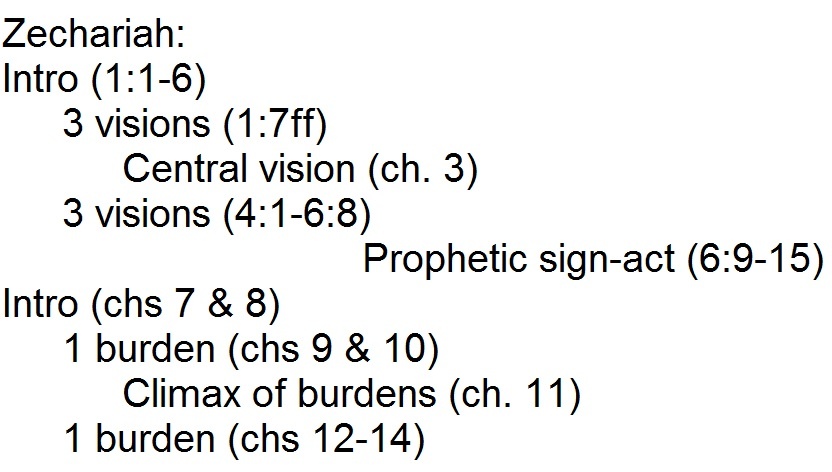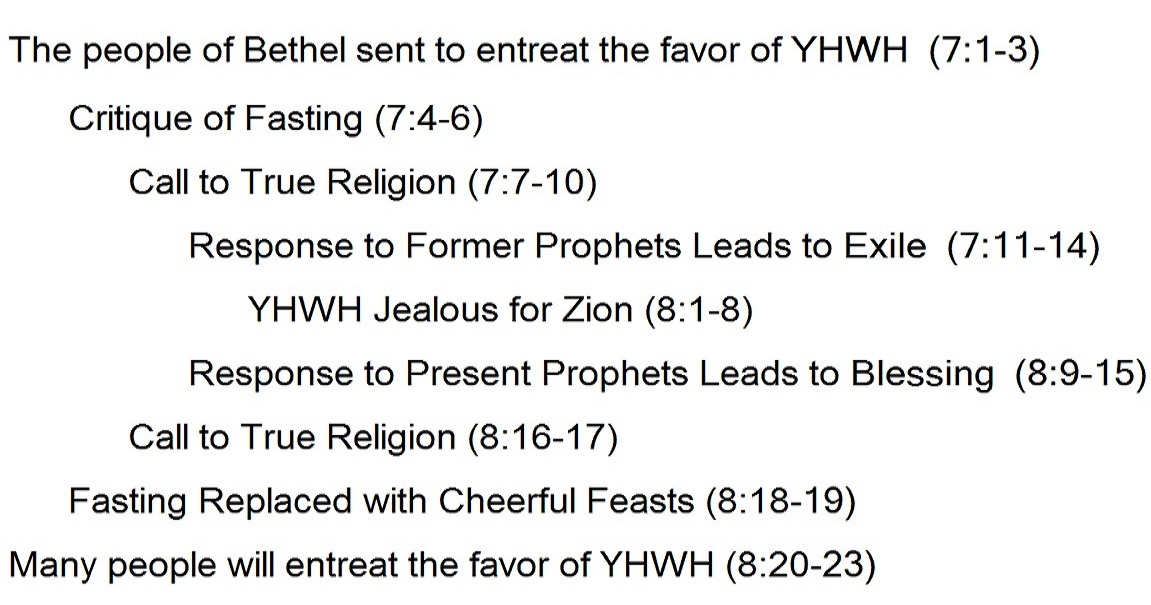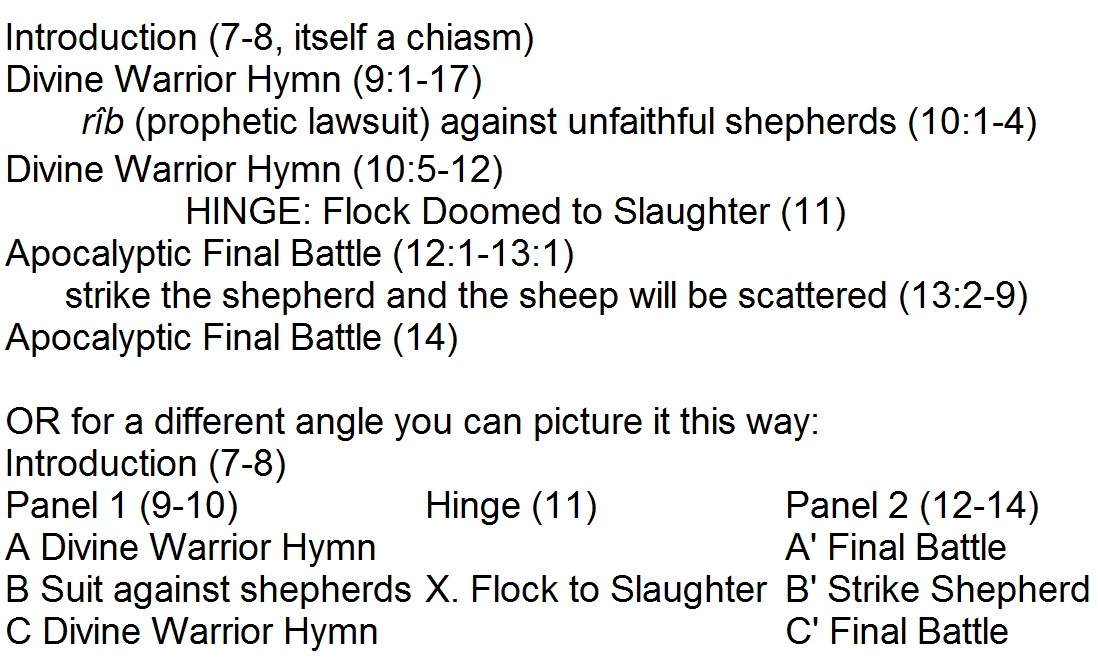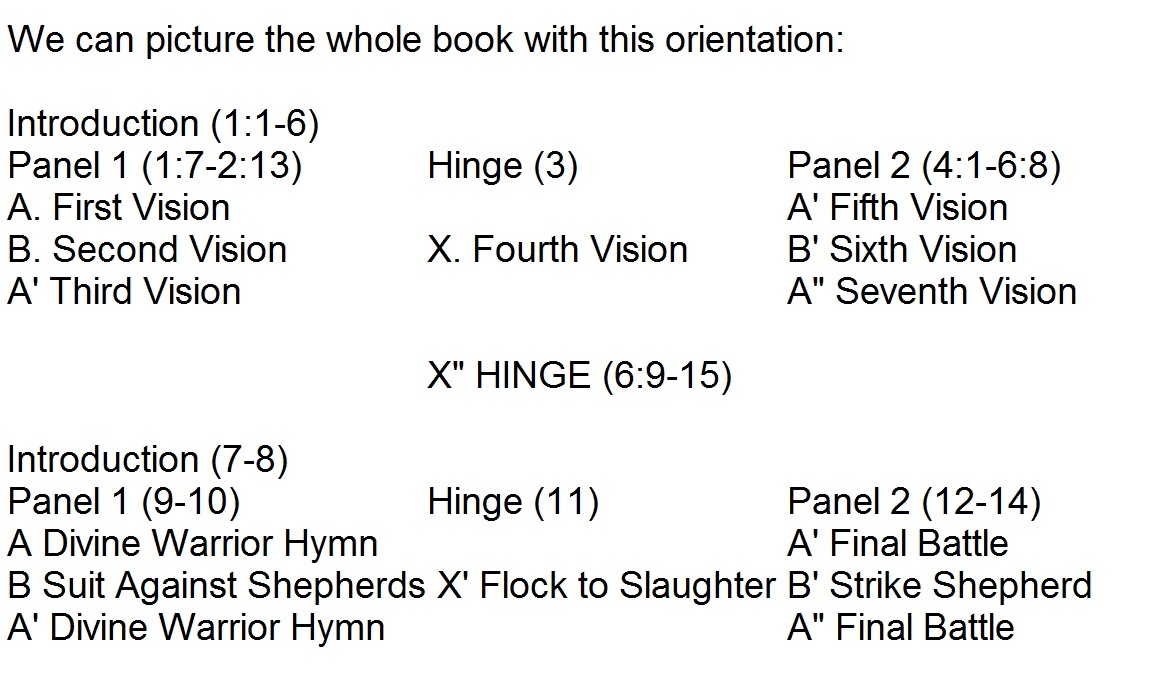Last time we talked about the structure of the whole book and examined the first introduction, the seven visions, and the climax of the book (Zech 6:9-15).
This time we have the second half of the book including the introduction to this half (chapters 7 & 8) and its two “burdens.” The introduction to the second half is dated to the fourth year of King Darius, on the fourth day of the ninth month. Given that the date of the first introduction was not the same as the date of the visions (compare Zech 1:1, 1:7) there is no guarantee that the date of the second introduction helps us to know the date of the burdens. Nevertheless, the structure of the book does suggest that we are looking at a unified literary whole and that chapters 7 and 8 should be read especially with what follows.
Concerning the similarities between the two introductions (Zech 1:1-6 and Zech 7-8), Kline notes the following examples: “an opening date formula for the revelation to Zechariah (1:1 and 7:1,4); recollection of lessons from past covenant history, accented by references to the lawsuit complaint of earlier prophets and the exile punishment (1:2-6 and 7:7-14; cf. 8:14); exhortation to fulfill present duty (1:3-4 and 8:16-17); promise to the repentant of new evidences of the Lord’s favor, replacing curses with blessings (1:3 and 8:2-15, 18-23).”
The introduction to the second half of the book is much longer than the first one. This is apparent even from the first four verses of Zechariah 7. Whereas the introduction at Zechariah 1:1 mentions both the timing and the indication that Zechariah received the following revelation from YHWH, Zechariah 7:1 tells us the date formula, then we get some prophetic historical background in verses 2-3, and then we are told, “Then the word of YHWH of Hosts came to me” (Zech 7:4). The background was that the people of Bethel “sent Sharezer and Regem-melech and their men to entreat the favor of YHWH.”
And we are told that these men came asking of the priests and prophets, “Should I weep and abstain in the fifth month, as I have done for so many years?” (Zech 7:3). The answer that YHWH of Hosts gives Zechariah to give is, “When you fasted and mourned in the fifth month and in the seventh, for these seventy years, was it for me that you fasted? And when you eat and when you drink, do you not eat for yourselves and drink for yourselves?” (Zech 7:5-6). These were questions calling for genuine self-examination.
And then Zechariah appealed to the prophetic lawsuits of earlier prophets: “Were not these the words that YHWH proclaimed by the former prophets, when Jerusalem was inhabited and prosperous, with her cities around her, and the South and the lowland were inhabited?” (Zech 7:7). So the earlier prophet to which Zechariah appeals had prophesied during a time of prosperity and peace in those regions. Verse 8 repeats the revelation formula: “And the word of YHWH came to Zechariah, saying,” and then the next two verses tell us the message of the earlier prophets afresh.
Boda’s commentary says that the earlier prophet foremost on Zechariah’s mind was Jeremiah and that Zechariah is using the vocabulary of Jeremiah 7:5-6. In the context of Jeremiah the people were relying on the Temple to avoid judgment. In Zechariah’s day the Second Temple was being built. McComiskey also sees Jeremiah 7:5-6 as the primary inspiration and notes that he had said the prophet Jeremiah was the inspiration also for Zechariah 1:4. Zechariah tells afresh the message of the prophet before the Exile of Judah and then says that the people refused to pay attention.
The call of the prophet had to do with true religion: “Render true judgments, show kindness and mercy to one another, do not oppress the widow, the fatherless, the sojourner, or the poor, and let none of you devise evil against another in your heart” (Zech 7:9-10).
The response: “But they refused to pay attention and turned a stubborn shoulder and stopped their ears that they might not hear. They made their hearts diamond-hard lest they should hear the law and the words that YHWH of Hosts had sent by His Spirit through the former prophets” (7:11-12).
The judgment: “Therefore great anger came from YHWH of Hosts” (Zech 7:12). The language of not paying attention and of YHWH being very angry with their fathers was also found in the first introduction (Zech 1:2-6). Zechariah 7 is just a more extended version hitting the same themes and ending with the people in exile.
As with chapter 7 we see a new paragraph with the opening of Zechariah 8: “And the word of YHWH of Hosts came, saying,” (Zech 8:1).
Chapter 8 then relates to us the good news that YHWH says He has returned to Zion and will dwell in the midst of Jerusalem. It reiterates the earlier exhortation: “These are the things that you shall do: Speak the truth to one another, render in your gates judgments that are true and make for peace; do not devise evil in your hearts against one another, and love no false oath, for all these things I hate, a declaration of YHWH” (Zech 8:16-17). He also answers the fasting question – He says the fast of the fourth, fifth, seventh, and tenth months “shall be to the house of Judah seasons of joy and gladness and cheerful feasts.”
The chapter ends in inclusio fashion to how it opened by talking of people entreating the favor of YHWH (Zech 8:21-23).
In this chapter Zechariah also appeals to the building of the Second Temple and the prophets who were present on the day that the foundation was laid (i.e. Haggai, though not mentioned by name). Actually noting the recurring themes of these things suggests the following chiasm: (my own analysis)
One emphasis of the second introduction is the theme we have already noted for Zechariah – the gospel going to the Gentiles. Thus the introduction ends, “Many peoples and strong nations shall come to seek YHWH of Hosts in Jerusalem and to entreat the favor of YHWH. Thus says YHWH of Hosts: In those days ten men from the nations of every tongue shall take hold of the robe of a Jew, saying, ‘Let us go with you, for we have heard that God is with you’” (Zech 8:22-23). YHWH is jealous for Zion (including Gentiles who will be gathered onto Mount Zion).
The first of two burdens begins, “The burden of the word of YHWH is against the land of Hadrach and Damascus is its resting place…” (Zech 9:1). Already you can see a big shift in style, much like that shift between the first introduction and the visions. And just as there were three visions in each panel in the first part of the book there are three parts to each of the burdens. Kline observes that each forms a chiasm (A,B,A’). For example, Kline cites Hanson’s identification of Zech 9:1-17 and 10:5-12 as divine-warrior hymns and the verses between as a rîb (prophetic lawsuit) against unfaithful shepherds.
The first divine warrior hymn (Zechariah 9) mentions a number of nations and places including Syria (Damascus is the capital), Tyre and Sidon; and Philistia including Ashkelon, Gaza, and Ekron (recall Zephaniah 2 (yes the other prophet)). The hymn tells of the defeat and subjugation of many nations . This is related to another theme of the hymn – the restoration of Zion. Once again Zion comes under God’s protection and His people inhabit it. This hymn is famous because it shows the Messiah king riding on a donkey into Jerusalem. Jesus fulfills this and His arrival is the end of the Exile.
The two divine warrior hymns especially overlap in emphasis when you compare Zechariah 9:4-6 and Zechariah 10:11. In both God strikes the sea, a king/scepter perishes, and the proud are humbled. Kline notes a number of key words are only found in Zechariah in these two divine warrior hymns. This includes “mighty warrior” (Zech 9:13, 10:5, 7) a verb for “joy” (Zech 9:9, 10:7), oppressor (Zech 9:8, 10:4), “battle bow” (Zech 9:10, 10:4), “mire of the streets” (Zech 9:3, 10:5), “as through wine” (Zech 9:15, 10:7). And Kline says to note Zech 9:10 and 10:11 for the similar double use of “sea” and north-south boundaries.
The portion in the middle (Zechariah 10:1-4) includes the shepherd/flock motif. “Therefore the people wander like sheep; they are afflicted for lack of a shepherd” (Zech 10:2c). And so YHWH says that His anger is hot against the shepherds and He will punish the male goats. YHWH of Hosts, on the other hand, cares for His flock, the house of Judah and will make them like His majestic steed in battle. This theme links it and the other hinges of this half of the prophetic book.
The climax of the burdens is Zechariah 11. Like the rîb at Zechariah 10:1-4, it includes the theme of the shepherd and flock. The shepherds or flocks are mentioned in Zechariah 11:3, 4, 5, 7, 8, 9, 15, 16, and 17. So the theme runs throughout this section. Considering the structure of the book we would also expect this section to have much in common with Zechariah 3, the central vision, and Zechariah 6:9-15 the prophetic sign-act climax of the book. And we are not disappointed.
Kline shows that something important happens in the house of YHWH in each (Zechariah 3:7, 6:12-14, and 11:13). Also important is that in each the Messianic royal-priest is judged relative to gold and silver. Thus the stone for Joshua the high priest in Zechariah 3:9, the crown in Zechariah 6:11, and those who reject the Messiah (the Good Shepherd) and value Him at 30 pieces of silver (Zechariah 11:12-13). The 30 pieces of silver is prophetic of the betrayal of Jesus by Judas for 30 pieces of silver. As a prophetic sign-act Zechariah is told to throw the 30 pieces of silver into the house of YHWH to the potter.
Most important is the prophet Zechariah’s personal actions in this chapter. Only in Zechariah 3, 6:12-14, and 11 do we see the prophet participate. And his level of involvement actually increases with each one. Once again the action is the commissioning of the Messianic royal-priest to His task but this time instead of Joshua the high priest playing the role of the one pointing to the Messiah it is Zechariah himself who does so. He plays the part of the Good Shepherd, shepherding is a common image for kingship, and his coronation is his taking up the appropriate shepherding outfit and such. Thus the shepherd’s staff (actually two) replaces the king’s scepter.
This section speaks about actual historical figures (some future like Judas) unlike the burdens on either side.
It is important to emphasize that in Zechariah the Good Shepherd suffers. So Zechariah in this chapter is a type pointing forward to Jesus Christ.
The second burden begins, “The burden of the word of YHWH concerning Israel…” (Zechariah 12:1). It also consists of three parts. The first and third parts are Zechariah 12:1-13:1 and 14:1-21. Zechariah 13:2-9 is the climax of these chapters. The first and third parts show, as Kline says, “the final gathering of the world forces against Jerusalem” (with the term for “gather” only found in Zechariah at Zechariah 12:3 and 14:2). He also observes the “sustained emphasis on the universal scale of the assault” (Zechariah 12:9, 14:2, 16; 12:3, 14:12; 12:2, 6; 14:14; 12:3; 14:17). So we see the battle of Har Maggedon.
The battle is described as a siege of Jerusalem (cf. Zechariah 12:2). “All the nations of the earth will gather against it” (Zechariah 12:3c). It is the day of YHWH thus “On that day” He says, “I will strike every horse with panic and its rider with madness” (Zechariah 12:4a). Again YHWH promises to protect Jerusalem “on that day” and even says the weakest “among them shall be like David, and the house of David shall be like God, like the angel of YHWH, going before them.” How fitting considering that the “angel of YHWH” earlier in Zechariah is none other than the pre-incarnate Son of David.
The final verse of the first section says, “On that day there shall be a fountain opened for the house of David and the inhabitants of Jerusalem, to cleanse them from sin and uncleanness” (Zechariah 13:1). Likewise the end of the third section describes the sanctification of the pots in Jerusalem as holy as the bowls before the altar in the Temple. The third section also describes the final battle when God will gather all the nations against Jerusalem to battle. It even says, “Then YHWH will go out and fight against those nations as when He fights on a day of battle” (Zech 14:3).
And then we see a description that resembles earlier imagery in Zechariah – “On that day His feet shall stand on the Mount of Olives that lies before Jerusalem on the east…” (Zech 14:4). So YHWH is standing in judgment and then “YHWH my God will come, and all the holy ones with Him” (Zech 14:5d). The apocalyptic nature of the passage is apparent and we see descriptions of living waters flowing from Jerusalem (Zech 14:8), YHWH as king over all the earth (Zech 14:9), and Jerusalem will be inhabited and never again be devoted to destruction in holy war (Zech 14:11).
The third part also describes a great panic from YHWH that will fall on those gathered against Jerusalem (Zechariah 14:13-14). As is commonly the case with prophecy, the future age is described in terms of the present – so the nations will keep the Feast of Tabernacles/Booths.
Thus to back up to the climax, the second part, of this section. It is Zechariah 13:2-9. Like the earlier climaxes of Zechariah 10:1-4 and Zechariah 11, it has the theme of shepherds and flocks. For example, it says, “Strike the shepherd and the sheep will be scattered” (cf. Zech 13:7, Matt 26:31, Mark 14:27). This section describes cutting off the names of the idols so that they will be not be remembered (worship word) and there is a discussion of false prophets. The section ends with the covenant formula: “I will say, ‘They are my people,’ and they will say, ‘YHWH is my God.”


Then when you turn the above image on its side again you will see that Zechariah 1:1-6:8 is one panel and Zechariah 7-14 is a second panel and the hinge of the book is Zechariah 6:9-15.
Such a design rules out the possibility that Zechariah 9-14 was written by a second author. But that is secondary to the primary concern that seeing the structure helps you to see the main point of the book – and it is all about Jesus Christ!
Recent Comments